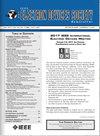Fault Tolerance of Oscillatory Neural Network: Device Oscillator-Based Small Network to Digital Oscillator-Based Large Networks
IF 2.4
3区 工程技术
Q3 ENGINEERING, ELECTRICAL & ELECTRONIC
引用次数: 0
Abstract
Oscillatory Neural Networks (ONN) are inevitable when it comes to solving combinatorial optimization problems. ONNs are also extremely energy efficient for AI workloads compared to conventional Deep Neural Networks (DNNs). Analysis of fault and failure tolerance of ONNs is crucial for understanding the reliability of the networks. This work illustrates the fault tolerance of the ONN in solving constraint optimization problems such as vertex coloring and digit recognition problems. For vertex coloring, a 4-node network across various configurations and different component failure levels has been analyzed using a device oscillator. The findings confirm that the network is highly robust to failures, demonstrating tolerance to variations in resistance of up to 40% and in capacitance of up to 60%. The analysis was then extended to bigger networks varying from 16-node network to 784-node network, using a digital oscillator for digit recognition of digits 0, 1, and 7. The results suggest that the tolerance shoots up rapidly as the network size increases, enhancing the stability of the ONN, making it highly robust. A saturation point exists beyond which the law of diminishing returns is observed. A tolerance of up to 99.9% in frequency fault and up to 59% in stuck-at fault is observed for extremely large networks of size 784 neurons.振荡神经网络的容错:基于器件振荡器的小网络到基于数字振荡器的大网络
振荡神经网络(ONN)在解决组合优化问题时是不可避免的。与传统的深度神经网络(dnn)相比,onn在人工智能工作负载方面也非常节能。分析网络的故障和容错能力对于理解网络的可靠性至关重要。这项工作说明了ONN在解决约束优化问题(如顶点着色和数字识别问题)中的容错性。对于顶点着色,使用设备振荡器分析了跨各种配置和不同组件故障级别的4节点网络。研究结果证实,该网络对故障具有高度鲁棒性,显示出对高达40%的电阻变化和高达60%的电容变化的容忍度。然后将分析扩展到更大的网络,从16节点网络到784节点网络,使用数字振荡器来识别数字0、1和7。结果表明,随着网络规模的增加,容忍度迅速上升,增强了网络的稳定性,使其具有很高的鲁棒性。存在一个饱和点,超过这个饱和点,就会出现收益递减规律。对于784个神经元的超大网络,频率故障容忍度高达99.9%,卡滞故障容忍度高达59%。
本文章由计算机程序翻译,如有差异,请以英文原文为准。
求助全文
约1分钟内获得全文
求助全文
来源期刊

IEEE Journal of the Electron Devices Society
Biochemistry, Genetics and Molecular Biology-Biotechnology
CiteScore
5.20
自引率
4.30%
发文量
124
审稿时长
9 weeks
期刊介绍:
The IEEE Journal of the Electron Devices Society (J-EDS) is an open-access, fully electronic scientific journal publishing papers ranging from fundamental to applied research that are scientifically rigorous and relevant to electron devices. The J-EDS publishes original and significant contributions relating to the theory, modelling, design, performance, and reliability of electron and ion integrated circuit devices and interconnects, involving insulators, metals, organic materials, micro-plasmas, semiconductors, quantum-effect structures, vacuum devices, and emerging materials with applications in bioelectronics, biomedical electronics, computation, communications, displays, microelectromechanics, imaging, micro-actuators, nanodevices, optoelectronics, photovoltaics, power IC''s, and micro-sensors. Tutorial and review papers on these subjects are, also, published. And, occasionally special issues with a collection of papers on particular areas in more depth and breadth are, also, published. J-EDS publishes all papers that are judged to be technically valid and original.
 求助内容:
求助内容: 应助结果提醒方式:
应助结果提醒方式:


